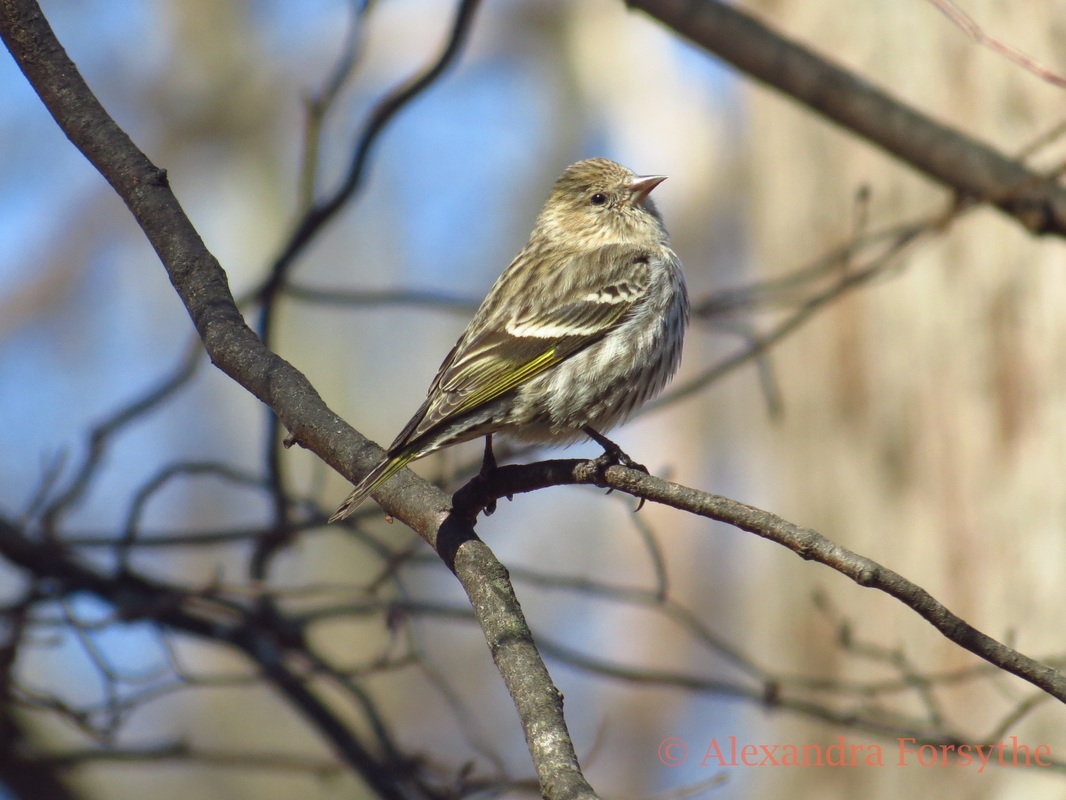This finch dressed like a sparrow can be seen in abundance one year, then rarely the next. The migration patterns are variable. During irruption years Pine Siskins travel further south and east in the winter in search of food. Normally seen in the northern states, some irruption years have resulted in large flocks of Siskins in places as far south as Louisiana, Alabama and Florida. In the winter of 2007-8 there were Pine Siskins reported at only 24% of the Project FeederWatch Sites. The following year was an irruption year, with 50% of the Project FeederWatch sites reporting flocks of Pine Siskins. Their movements are variable, with some migrating from northeast to northwest, while others migrate from north to south. A Siskin banded in Pennsylvania was later recaptured in Washington, while another bird banded in Texas was recaptured in Minnesota. They migrate in flocks of a half dozen to hundreds, often stopping at nyjer feeders along the way to dine alongside goldfinches.
They consume a variety of insect and weed pests, including aphids, scale insects, and thistle. As the flock forages through the trees, parts of the flock "leapfrog" over one another. "Often when feeding, there are no birds in flight; at other times part of the flock may take wing and pass over those still feeding to other food trees. As the birds thus go "leapfrogging", the entire mass of the flock of busy, lisping birds appears to flow through the forest. Then all of a sudden the lisping ceases and the flock is silent; it takes flight with a very audible whirring of wings and flies rapidly away" - A. C. Bent, "Life Histories of Familiar North American Birds".
The courtship is a sweet combination of a song and a dance on the wing. Louise de Kiriline Lawrence, naturalist and frequent contributor to National Audubon Society's magazine "Audubon", described the courtship beautifully: "With a beam of sunshine illuminating his golden flashes, the male rose into the air with tail spread wide and wings in a blur of rapid motion. To the accompaniment of a flight song which seemed to express far more musical adoration than could be contained in so small a body, he described circle after circle around his chosen mate. That the female reflected none of her partner's emotion in no way seemed to dampen his ardor and, after he dropped on to a twig from pure exhaustion to catch his breath, a few moments later he rose again in a repeat performance no less ecstatic than the first... In the midst of all this sweet singing, two birds swing into the air in an extensive 'cloud chase,' their movements tightly synchronized as they alternate in the roles of pursuer and pursued... The female sat on a twig. Presently the male alighted on the same twig, hopped up to her and offered her a small particle, of what I could not see. She crouched and, with trembling wings, accepted the offering."
Siskins are often thought to be rather tame. E. R. Davis studied the Siskins in 1926 and wrote: "In a short time the birds came to regard me as their friend, and in the days that followed grew to be exceedingly sociable and to lose every vestige of fear. Whenever I would appear at the window, or step outside the door, down they would come and, settling upon my head, shoulders, and arms, would peer anxiously about for the food that they had learned to know I held concealed from them in a box, dish, or other receptacle."
Pine Siskins may be tame, but they are also tough. They can withstand temperatures down to -94˚ (that's 94 degrees below zero!) by increasing their metabolic rate up to five times their normal rate for several hours! They also put on large fat deposits to help insulate themselves, and they store 10% of their body weight in seeds inside their crop to sustain them for up to 6 hours in subzero nighttime temperatures.

 RSS Feed
RSS Feed
